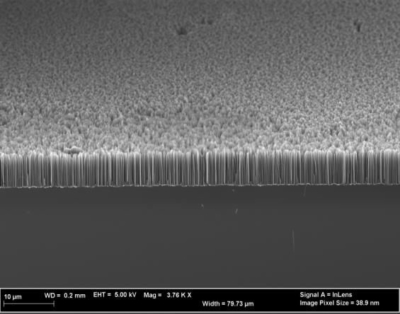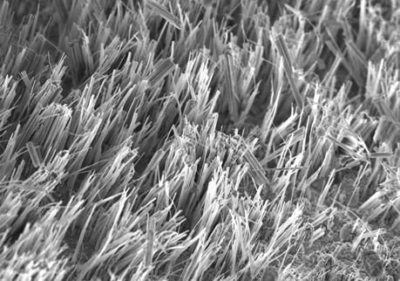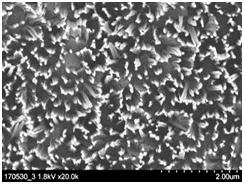How Si Nanowires Are Made
Silicon nanowire arrays or SiNWs are vertically aligned arrays of silicon nanowires on a planar crystalline silicon wafer substrate. These nanowires are made by a catalytic oxidation and dissolution of Si in the presence of metal catalyst nanoparticles – a self-organized process commonly referred to as metal enhanced etching, metal assisted chemical etching (MACE), or metal assisted etching (MAE) . This process has been known for many decades (Li, Bohn, Appl. Phys. Lett. 77, 2572 (2000)).
InRedox’s partner, Advanced Silicon Group, have innovated on the MACE processes to make resulting Si Nanowire arrays more reproducible and uniform, and to allow the properties of the nanowires to be tuned.
The MACE process always involves deposition of a metal and etching in a solution containing hydrofluoric acid (HF) and an oxidizer. The silicon is etched only where the metal nanoparticle touches the silicon, as a result of coupled electrochemical reactions mediated by the nanoparticle. As the silicon is etched, the nanoparticles move into the resulting nanopores. Since the silicon is only etched locally, the process can result in features with very high aspect ratio.
The process can be tuned by adjusting the following parameters:
- Type of metal
- Deposition method of metal
- Preparation of the silicon surface prior to metal deposition
- Treatment of the metal before etching
- Chemistry of the etching solution
- Parameters during the etching process
- Type of oxidizer used in the etching process
For more information on the MACE process see review by Toor, Black et al, Nanotechnology 27, 412003 (2016).
Si Nanowire Arrays Products
Arrays of Si nanowires based on this technology are now offered by InRedox through a partnership with Advanced Silicon Group (ASG).
Properties of Si Nanowires




